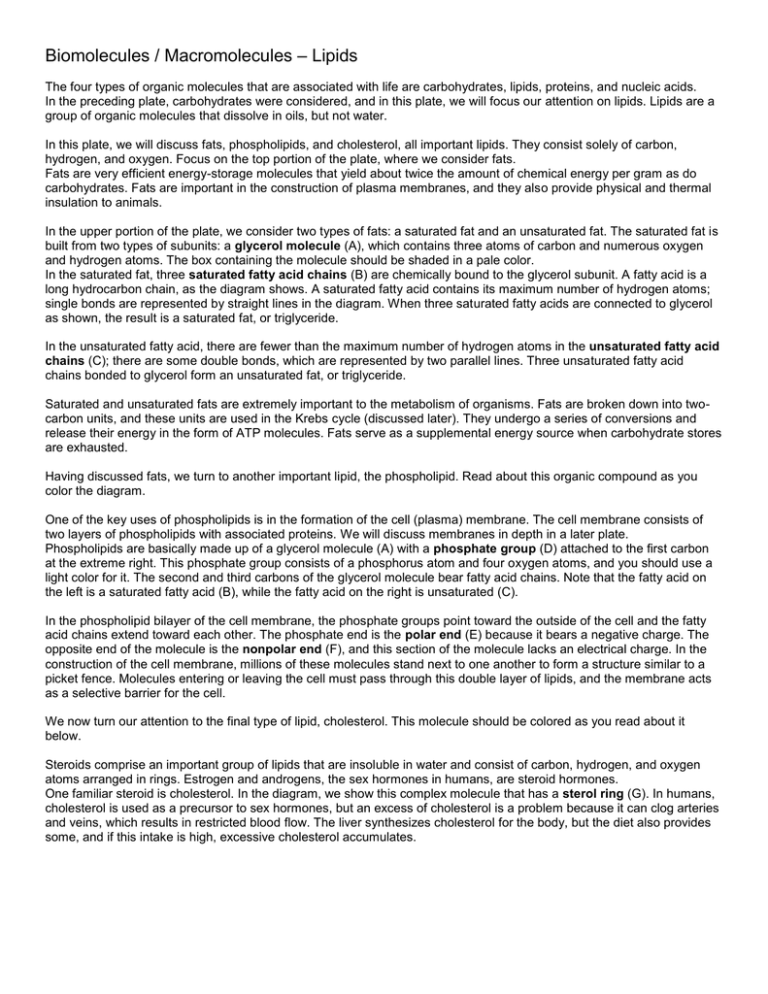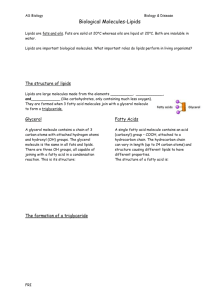Biomolecules / Macromolecules – Lipids The four types of organic
advertisement

Biomolecules / Macromolecules – Lipids The four types of organic molecules that are associated with life are carbohydrates, lipids, proteins, and nucleic acids. In the preceding plate, carbohydrates were considered, and in this plate, we will focus our attention on lipids. Lipids are a group of organic molecules that dissolve in oils, but not water. In this plate, we will discuss fats, phospholipids, and cholesterol, all important lipids. They consist solely of carbon, hydrogen, and oxygen. Focus on the top portion of the plate, where we consider fats. Fats are very efficient energy-storage molecules that yield about twice the amount of chemical energy per gram as do carbohydrates. Fats are important in the construction of plasma membranes, and they also provide physical and thermal insulation to animals. In the upper portion of the plate, we consider two types of fats: a saturated fat and an unsaturated fat. The saturated fat is built from two types of subunits: a glycerol molecule (A), which contains three atoms of carbon and numerous oxygen and hydrogen atoms. The box containing the molecule should be shaded in a pale color. In the saturated fat, three saturated fatty acid chains (B) are chemically bound to the glycerol subunit. A fatty acid is a long hydrocarbon chain, as the diagram shows. A saturated fatty acid contains its maximum number of hydrogen atoms; single bonds are represented by straight lines in the diagram. When three saturated fatty acids are connected to glycerol as shown, the result is a saturated fat, or triglyceride. In the unsaturated fatty acid, there are fewer than the maximum number of hydrogen atoms in the unsaturated fatty acid chains (C); there are some double bonds, which are represented by two parallel lines. Three unsaturated fatty acid chains bonded to glycerol form an unsaturated fat, or triglyceride. Saturated and unsaturated fats are extremely important to the metabolism of organisms. Fats are broken down into twocarbon units, and these units are used in the Krebs cycle (discussed later). They undergo a series of conversions and release their energy in the form of ATP molecules. Fats serve as a supplemental energy source when carbohydrate stores are exhausted. Having discussed fats, we turn to another important lipid, the phospholipid. Read about this organic compound as you color the diagram. One of the key uses of phospholipids is in the formation of the cell (plasma) membrane. The cell membrane consists of two layers of phospholipids with associated proteins. We will discuss membranes in depth in a later plate. Phospholipids are basically made up of a glycerol molecule (A) with a phosphate group (D) attached to the first carbon at the extreme right. This phosphate group consists of a phosphorus atom and four oxygen atoms, and you should use a light color for it. The second and third carbons of the glycerol molecule bear fatty acid chains. Note that the fatty acid on the left is a saturated fatty acid (B), while the fatty acid on the right is unsaturated (C). In the phospholipid bilayer of the cell membrane, the phosphate groups point toward the outside of the cell and the fatty acid chains extend toward each other. The phosphate end is the polar end (E) because it bears a negative charge. The opposite end of the molecule is the nonpolar end (F), and this section of the molecule lacks an electrical charge. In the construction of the cell membrane, millions of these molecules stand next to one another to form a structure similar to a picket fence. Molecules entering or leaving the cell must pass through this double layer of lipids, and the membrane acts as a selective barrier for the cell. We now turn our attention to the final type of lipid, cholesterol. This molecule should be colored as you read about it below. Steroids comprise an important group of lipids that are insoluble in water and consist of carbon, hydrogen, and oxygen atoms arranged in rings. Estrogen and androgens, the sex hormones in humans, are steroid hormones. One familiar steroid is cholesterol. In the diagram, we show this complex molecule that has a sterol ring (G). In humans, cholesterol is used as a precursor to sex hormones, but an excess of cholesterol is a problem because it can clog arteries and veins, which results in restricted blood flow. The liver synthesizes cholesterol for the body, but the diet also provides some, and if this intake is high, excessive cholesterol accumulates.





